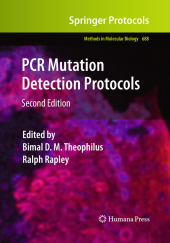 Neuerscheinungen 2016Stand: 2020-02-01 |
Schnellsuche
ISBN/Stichwort/Autor
|
Herderstraße 10
10625 Berlin
Tel.: 030 315 714 16
Fax 030 315 714 14
info@buchspektrum.de |

Ralph Rapley, Bimal D.M. Theophilus
(Beteiligte)
PCR Mutation Detection Protocols
Herausgegeben von Theophilus, Bimal D.M.; Rapley, Ralph
2. Aufl. 2016. x, 298 S. 18 Tabellen. 254 mm
Verlag/Jahr: SPRINGER, BERLIN; HUMANA PRESS 2016
ISBN: 1-493-95629-9 (1493956299)
Neue ISBN: 978-1-493-95629-6 (9781493956296)
Preis und Lieferzeit: Bitte klicken
The Second Edition updates the subject with key protocols involving the PCR and its many incarnations such as SSCP, CSGE, and dHPLC. The book also addresses such areas as Southern blotting, accurate diagnostics with high throughput, and microarray systems.
Since the publication of the popular first edition, the explosion of DNA sequence information, the access to bioinformatics and mutation databases coupled with the ability to readily detect and confirm mutations has cemented the role of molecular diagnostics in medicine and, in particular, mutation detection by the polymerase chain reaction (PCR). In PCR Mutation Detection Protocols, Second Edition, expert researchers bring the subject up-to-date with key protocols involving the PCR and its many various incarnations such as SSCP, CSGE, and dHPLC. The volume also addresses key areas such as Southern blotting, accurate diagnostics with high throughput, as well as microarray systems. Written in the highly successful Methods in Molecular Biology(TM) series format, chapters include brief introductions their respective topics, lists of the necessary materials and reagents, step-by-step, readily reproducible laboratory protocols, and notes which provide the often hard to find information that may mean the difference between the success and failure of the method.
Authoritative and cutting-edge, PCR Mutation Detection Protocols, Second Edition aims to stimulate postgraduate scientists, researchers, and clinicians already engaged in the area and to provide an important first step for those new to this practice wanting to adopt the powerful and essential technique in their own laboratories.


